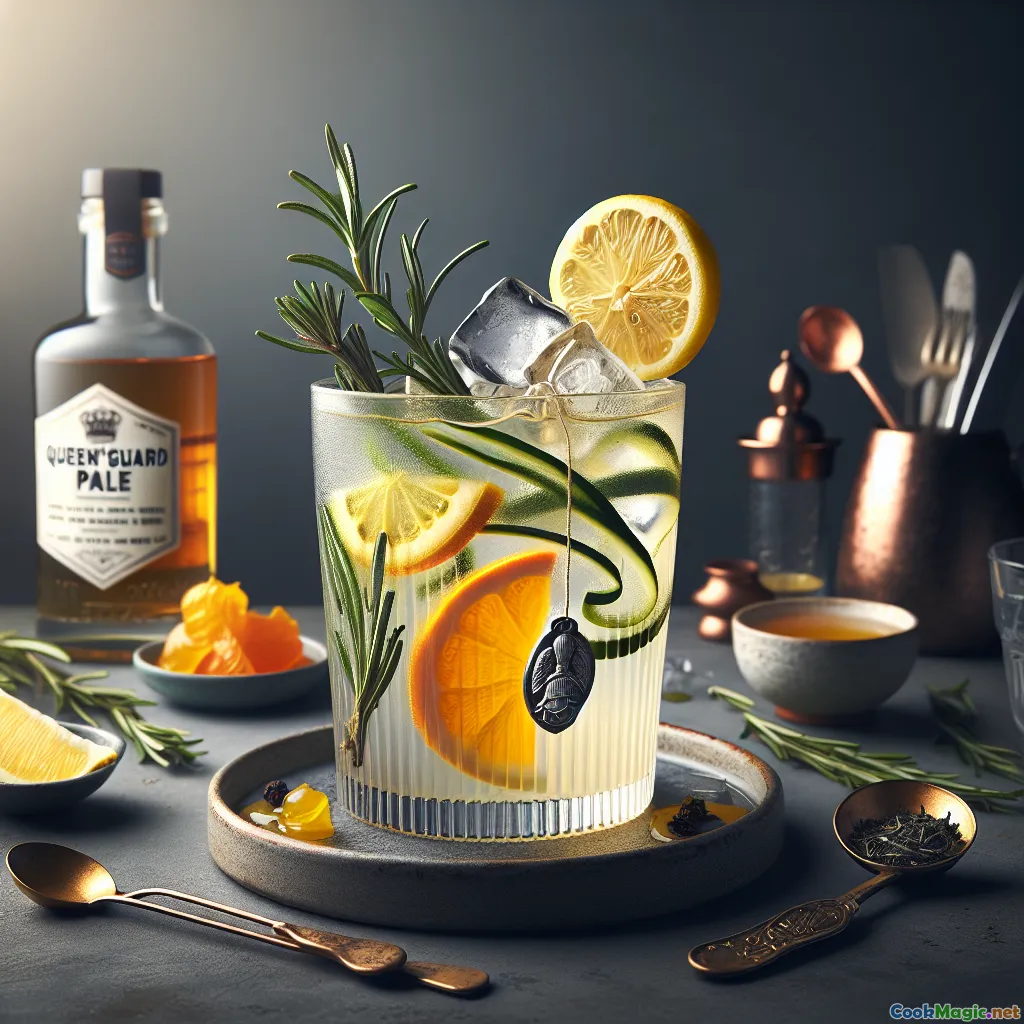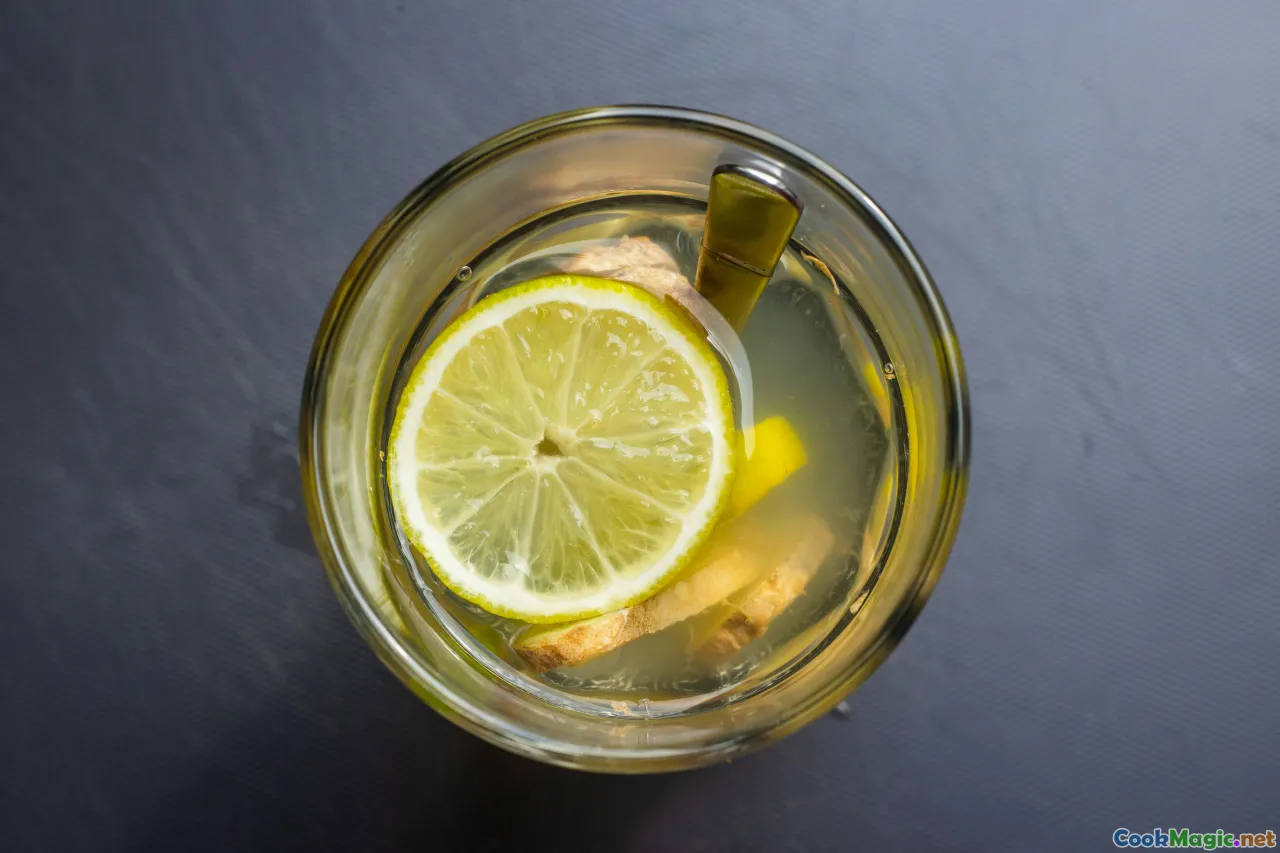
جين-إيرل جري بايل آيل فِز
(Gin-Earl Grey Pale Ale Fizz)
(0 المراجعات)المكونات
-
45 ml جين لندن الجاف
(Classic British style gin)
-
20 ml عصير ليمون طازج
(عصير طازج معصور، مصفّى)
-
2 dashes مرّارة البرتقال
(Angostura Orange or similar)
-
120 ml بيرة بيل أيل الإنجليزية
(Well-chilled; moderately bitter, not overly hoppy)
-
6 cubes مكعبات الثلج
(Clear ice preferred for slower dilution)
-
1 sprig غصن إكليل الجبل
(Lightly slapped to release aroma)
-
1 strip قشر الليمون
(Wide strip for expressing oils)
-
30 ml ماء
(For Earl Grey honey syrup)
-
30 ml عسل سائل
(Prefer English wildflower; for syrup)
-
1 bag كيس شاي إيرل جراي
(Bergamot-scented black tea; for syrup)
-
1 piece شريط الخيار
(Optional crisp garnish)
(Classic British style gin)
(عصير طازج معصور، مصفّى)
(Angostura Orange or similar)
(Well-chilled; moderately bitter, not overly hoppy)
(Clear ice preferred for slower dilution)
(Lightly slapped to release aroma)
(Wide strip for expressing oils)
(For Earl Grey honey syrup)
(Prefer English wildflower; for syrup)
(Bergamot-scented black tea; for syrup)
(Optional crisp garnish)
التغذية
- الحصص: 1
- حجم الحصة: 1 highball (300 ml)
- Calories: 195 kcal
- Carbohydrates: 18 g
- Protein: 0 g
- Fat: 0 g
- Fiber: 0 g
- Sugar: 15 g
- Sodium: 10 mg
- Cholesterol: 0 mg
- Calcium: 6 mg
- Iron: 0.2 mg
التعليمات
-
1 - Brew Earl Grey honey syrup:
Heat the water to just off the boil. Steep the Earl Grey tea bag for 3 minutes, remove the bag, then stir in honey until fully dissolved. Cool. Yields about 60 ml; you’ll use 20 ml.
-
2 - Chill glass and beer:
Fill a highball with ice to chill. Keep the pale ale in the fridge or on ice so it pours crisp and gentle with a tight head.
-
3 - Shake the Base:
In a shaker, add gin, 20 ml cooled Earl Grey honey syrup, lemon juice, and orange bitters. Add ice and shake hard for 10–12 seconds to chill and aerate.
-
4 - Strain and top with pale ale:
Discard the chilling ice from the glass. Fine-strain the shaken mixture into the glass over fresh ice. Gently top with chilled English pale ale (about 120 ml), tilting the glass to reduce foaming.
-
5 - Garnish aromatically:
Express the lemon peel oils over the drink and rim, then add peel. Lightly slap the rosemary sprig and nestle it in. Add cucumber ribbon if using. Give one gentle stir to integrate.
-
6 - Serve:
Serve immediately while icy-cold and effervescent, letting the aromas of bergamot and rosemary bloom with each sip.
Heat the water to just off the boil. Steep the Earl Grey tea bag for 3 minutes, remove the bag, then stir in honey until fully dissolved. Cool. Yields about 60 ml; you’ll use 20 ml.
Fill a highball with ice to chill. Keep the pale ale in the fridge or on ice so it pours crisp and gentle with a tight head.
In a shaker, add gin, 20 ml cooled Earl Grey honey syrup, lemon juice, and orange bitters. Add ice and shake hard for 10–12 seconds to chill and aerate.
Discard the chilling ice from the glass. Fine-strain the shaken mixture into the glass over fresh ice. Gently top with chilled English pale ale (about 120 ml), tilting the glass to reduce foaming.
Express the lemon peel oils over the drink and rim, then add peel. Lightly slap the rosemary sprig and nestle it in. Add cucumber ribbon if using. Give one gentle stir to integrate.
Serve immediately while icy-cold and effervescent, letting the aromas of bergamot and rosemary bloom with each sip.
المزيد عن : جين-إيرل جري بايل آيل فِز
Queen’s Guard Pale: A British Beertail with Tea-Time Elegance
The Queen’s Guard Pale is a spirited salute to British tradition, combining three pillars of the isle’s drinking culture: London dry gin, proper tea, and pale ale. This cocktail layers a brisk, bergamot-kissed Earl Grey honey syrup against bright lemon and juniper-driven gin, then crowns it with a gentle pour of chilled English pale ale. The result is a gilded, lightly bitter fizz with honeyed softness, citrus lift, and a garden-note of rosemary—refined enough for a royal garden party, yet relaxed enough for a Sunday pub roast.
Why It Works
- Balance: Pale ale’s malt sweetness and hop bitterness harmonize with the tartness of lemon and the floral sweetness of honey. Gin’s botanicals bridge the tea’s bergamot and the ale’s hops.
- Texture: A brief shake introduces micro-aeration to the base, giving a soft cloudiness that meets the ale’s fine bubble. The finish is dry but not austere.
- Aroma: Expressed lemon oils and a slapped rosemary sprig frame the first sip with bright, herbal perfume.
Tips & Notes
- Syrup finesse: Brew the Earl Grey slightly strong (3 minutes is ideal) to ensure the tea character shines once diluted by ice and beer. Over-steeping can introduce astringency, so mind the timer.
- Ale choice: Choose an English pale ale or bitter with moderate bitterness (around 25–35 IBUs). A highly resinous IPA may overshadow the delicate bergamot and gin. Cask-conditioned styles are lovely if you can keep them cold and lightly carbonated.
- Gin style: London dry gin keeps the palate clean. If you enjoy softer florals, a contemporary gin with citrus-forward botanicals can be delightful, but avoid overly sweetened styles.
- Honey selection: English wildflower or heather honey complements the tea. A lighter clover honey yields a subtler profile; darker honeys can dominate.
- Chill everything: Cold beer and cold glassware preserve carbonation and prevent the head from foaming over. Always top gently along the glass wall.
- Garnish technique: Slapping rosemary releases oils without pulverizing the herb. Express the lemon peel first to set a bright top note, then add the rosemary to frame it.
Substitutions & Variations
- No honey? Use a 1:1 simple syrup and add 1 small drop of quality bergamot extract to mimic Earl Grey’s signature aroma.
- Non-alcoholic: Swap gin for a zero-proof botanical spirit and use a non-alcoholic pale ale. Brew a stronger tea syrup to maintain flavor intensity.
- Herbal swap: Thyme or a bay leaf can replace rosemary for a different British-garden vibe.
- Fruit twist: Add 10 ml of dry orange liqueur or a barspoon of orange marmalade for a marmalade tea-time nod.
Serving & Pairing
Serve in a tall, chilled highball or a straight-sided pilsner for an elegant silhouette. It pairs beautifully with salt-and-vinegar crisps, beer-battered fish, a cheddar ploughman’s, or smoked salmon finger sandwiches—each echoing the cocktail’s citrus and herbal notes.
History & Cultural Significance
The inspiration is proudly British. Pale ale—thanks to Burton-on-Trent’s mineral-rich water—became the hallmark of English brewing, prized for clarity, hops, and a brisk, dry finish. Gin, once the “spirit of London,” matured from the rough days of the Gin Craze to the polished London dry we celebrate today. Earl Grey tea, perfumed with bergamot, is shorthand for English refinement and ritual. Historically, beer-and-gin combinations have pedigree: think the Victorian “Dog’s Nose,” an ale stirred with gin and spices. Queen’s Guard Pale refines that lineage, folding tea-time civility into pub-friendly refreshment.
Unique Aspects
- Triple British thread: gin, tea, and pale ale—a rarely united trio that reads quintessentially English yet feels modern.
- Aroma engineering: The bergamot-honey syrup links citrus, floral, and bitter components without extra sugar heft.
- Low-waste prep: The syrup’s small batch prevents leftovers; any remaining spoonful keeps for a week refrigerated.
Technique Highlights
- Shake-then-top: Shaking the base separately reduces ale agitation, keeping the pour controlled and carbonated.
- Fine strain: This yields a polished texture that lets the rosemary and lemon aromatics shine against the beer’s collar of foam.
- Gentle integration: One slow stir after topping prevents stratification while preserving bubbles.
Final Thoughts
Queen’s Guard Pale feels like changing-of-the-guard precision with a wink of British whimsy. Each sip moves from lemon brightness to honeyed tea, then lingers on gentle hops and juniper. It’s a conversation-starter at parties and an easy upgrade to casual gatherings. When you crave a drink that is undeniably English—neither too stiff nor too sweet—this beertail stands at attention, ready to serve.























